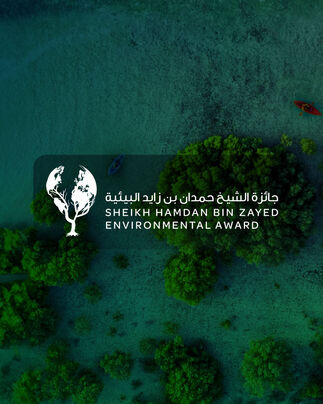Environment Agency – Abu Dhabi (EAD) has announced that its programme to reintroduce the scimitar-horned oryx in Chad has been successful in improving the conservation status of the species. The scimitar-horned oryx is now back in the wild and been reclassified as Endangered by the International Union for the Conservation of Nature (IUCN) Red List, after formerly being categorised as Extinct in the Wild.
The reintroduction programme, initiated in 2014, sought to promote a healthy and self-sustaining population in its natural habitat within Chad’s Ouadi Rimé-Ouadi Achim Faunal Reserve. Since 2016, EAD has successfully translocated 285 scimitar-horned oryx into the wild in Chad, with wild herd numbers increasing to more than 600 scimitar-horned oryx by 2023, exceeding the original target of 500. Prior to their introduction, there were no oryx left in the wild.
The reclassification reflects the impact of the reintroduction programme, which was founded under the directive of His Highness Sheikh Hamdan bin Zayed Al Nahyan, Chairman of the Board of Directors of EAD and inspired by the conservation legacy of the late Sheikh Zayed bin Sultan Al Nahyan.
Her Excellency Dr Shaikha Salem Al Dhaheri, Secretary-General of EAD, said: “We are extremely honoured and proud to announce that after years of hard work, we were able to successfully downlist the status of the scimitar-horned oryx from being Extinct in the Wild to Endangered according to the International Union for the Conservation of Nature Red List. We would not have been able to achieve this remarkable goal without the support and commitment of our leadership, who take their inspiration from the late Sheikh Zayed.
“The reintroduction of species is a very long-term endeavour and calls for strong commitment, specialised knowledge and skills, solid partnerships, and significant funding – all of which were an integral part of the scimitar-horned oryx reintroduction programme and resulted in its resounding success. We are extremely proud to have led this extraordinary conservation initiative in partnership with the Ministry of Environment, Fisheries and Sustainable Development, Sahara Conservation, the Smithsonian's National Zoo and Conservation Biology Institute, the Zoological Society of London, the Royal Zoological Society of Scotland, Saint Louis Zoo, Fossil Rim Wildlife Centre and the Crown Prince Court.
“Regarded as one of the most ambitious large mammal conservation reintroduction programmes in the world, the initiative has given hope for species restoration and has ignited interest both globally and in our region in attempting programmes of a similar nature. The downlisting of the oryx is a major step forward in our efforts to improve the conservation status and chance of long-term survival of other endangered species such as the addax and dama gazelle. Research shows that the overall survival rate is greater than 85 per cent in the wild.”
Her Excellency said: “One of the elements that contributed to our success was the experience we gained from our successful reintroduction programme of the Arabian oryx in Abu Dhabi. We realised that once we were successful within the UAE, then we should go beyond its borders.
“The current downlisting of the scimitar-horned oryx is a very significant conservation milestone, but not the end of our collective efforts. We hope that the success of this programme will inspire other partners to come forward and further support the rebuilding of scimitar-horned oryx, especially that the project has also benefited the community through capacity building, raising awareness and hiring of local people.”
His Excellency Mahamat Aabdelkerim Hanno, Chad Minister of the Environment, Fisheries, and Sustainable Development, said: “This is a historic moment not only for the scimitar-horned oryx but also for the Ouadi Rimé-Ouadi Achim Faunal Reserve and for Chad. After more than three decades of absence, the return of the oryx is a testament to the commitment of both the Chadian government and the Chadian people to biodiversity conservation. It is our joint responsibility to ensure the protection of all wildlife, as well as its habitat to restore species like the oryx to their rightful place. Protecting the environment and wildlife is a concern and a priority for us all.”
Tim Woodfine, Chief Executive Officer of Sahara Conservation, said: “At this critical time for our planet, the downlisting of the scimitar-horned oryx is a testament to collaboration and aspirations of all concerned to restore nature at scale. Downlisting of the oryx marks a milestone in one of the most ambitious conservation programs ever undertaken and contributes to putting the Sahara and the Sahel more firmly on the global conservation map. The initiative is a glowing example of what can be achieved to save Africa’s imperiled wildlife if we all pull together and combine our conservation efforts.
“Thanks to the vision and leadership of the Environment Agency of Abu Dhabi, and to a strong partnership, negative conservation trends can be halted, stabilised and reversed. The successful reintroduction of the scimitar-horned oryx is paving the way for the recovery of other critically endangered species, like the addax and the dama gazelle, which are already benefitting from the conservation efforts in Chad. This fantastic result reminds us that efforts must continue to secure the long-term survival of what is still a threatened species, assuring partners and donors that we are on the right track.”
Andrew Terry: Director of Conservation and Policy at ZSL, said: “Species that are classified as Extinct in the Wild become almost so threatened that some call them lost causes. But this stunning achievement is a testament to what is possible. Building upon a great foundation of knowledge and expertise, and through the vision and support of the Environment Agency of Abu Dhabi, this partnership has not only brought this species back from the very brink of extinction, but established a viable future for many other species. The programme has also supported protection of the local habitat, and training for local rangers and the community. This has made a huge contribution to conservation that must continue to be replicated and scaled.”
Brandie Smith, the John and Adrienne Mars Director of the Smithsonian's National Zoo and Conservation Biology Institute, said “The downlisting of the scimitar-horned oryx marks an exciting new chapter in the species' story. This milestone affirms that when global partners work together, we save species. We look forward to continuing our partnerships to protect the scimitar-horned oryx and other endangered species across the Sahel.”










